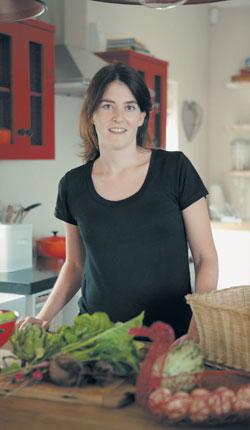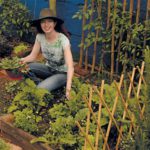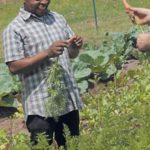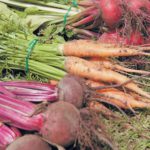Farming is making its mark across the urban landscape
RICHARD HOLMES
If necessity is the mother of invention, then scarcity is surely the father of urban farming. And the scarcity of locally grown seasonal produce which hasn’t clocked up a few thousand food miles from farm to fork is just one of the reasons behind a groundswell of ‘urban farmers’ who are turning vacant patches of land – from their own back gardens to tracts of suburbia – into a cornucopia of fresh produce. Cape Town-based Matt Allison has become something of a poster boy for the local urban farming movement, but clad in a pair of dusty jeans and scuffed Wellington boots, he seems less of an agriculture advocate and simply a man passionate about produce.
“As I became a more proficient cook, I started getting really interested in the provenance of food. I started asking myself: ‘Could this food be better?’” explains Matt as the sun beats down on his urban farm in the Constantia suburbs. “It motivated me to start growing my own food, and from there to supporting a wider community at local markets.”
That wider community has grown to include a selection of the most talked-about eateries in Cape Town, as chefs begin to tap into the wealth of urban produce on their doorstep. “My goal is to provide organically grown produce at a reasonable price… and my prices are usually comparable to mainstream supermarkets. Chefs are buying more and more produce from me, and it’s fantastic that they have a say in how their ingredients are grown,” says Matt. “This is where agriculture was 30 years ago, before it became agri-business: you had a relationship between the purveyor and the grower.” It’s a relationship Matt nurtures with the public at weekly markets too, but for a one-on-one rapport with your radish, there’s little to beat growing your own.
Jane Griffiths has perhaps done more than most to promote the notion of urban farming, thanks to her best-selling book, Jane’s Delicious Garden. “Gone are the days of a veggie garden being the poor cousin of the property,” laughs Jane down the line from her Johannesburg home. “My vegetable garden takes pride of place, even though it’s a complete patchwork of plants. Much of my garden is on tall tripods: things such as gem squash, butternut, tomatoes and beans. Then I mix it up by growing herbs and flowers in amongst the vegetables: it confuses the insects and provides me with wonderful edible flowers.”
While most of Jane’s produce ends up in her own kitchen, or that of friends, many up-country growers are offering their goods to the public: “Johannesburg’s restaurants are tapping into buying from small-scale urban farmers, and there’s been a huge increase in organic markets where the public can buy locally grown vegetables too,” she says.
And apart from generating fewer food miles, the fact that urban farmers are invariably small-scale operations without storage facilities means that seasonality and freshness come standard. “Observing seasonality is key to getting good produce. It sounds like stating the obvious, but it’s actually incredibly rare,” says Matt in his high-energy patter. “South Africa’s largest table grape exporter told me that if they get their fruit to European markets in five weeks, it’s considered fresh! To me that’s just crazy. With urban produce, you get to work with a local farmer and you get the freshest produce that’s in season right now. And you get to taste heirloom fruit and vegetables you probably haven’t tasted before.”
Heirlooms – open-pollinated varieties where unaltered seeds have been saved and stored through the generations – are the gold standard of small-scale urban farming,offering an eye-watering array of fruit and vegetables that have long since disappeared from the supermarket shelves. “Our farm is largely heirlooms: we have five varieties of heirloom lettuce and five of radish. We have eight heirloom tomatoes, and hope to have 16 varieties soon,” says Matt. “Unlike hybridised varieties, heirlooms allow me to save the seeds from this crop and get exactly the same crop next year.”
“I started my garden because I wanted to cook with heirloom vegetables, and the only way I could get my hands on exactly what I wanted was if I grew them myself,” says Bernadette Le Roux, chef and co-author of the awardwinning cookbook, Prickly Pears & Pomegranates. “I’ve tried to keep the garden nearly all heirlooms, but the vegetables I’m most excited about are the Turk’s turban pumpkins. Then I have a lovely range of tomatoes – including tiger-striped black tomatoes and golden monarchs – as well as colourful Easter egg radishes.”
While the bulk of Bernadette’s produce ends up in her stylish farmhouse kitchen, a bumper harvest often sees a basket of excess vegetables going down the road to the family-owned restaurant, Café Roux. “I had so many broad beans last season!” laughs Bernadette. It’s a common problem, and nearly all small-scale growers will bemoan the inevitable feast or famine as a glut of one crop arrives when another dwindles.
“My second book – Jane’s Delicious Kitchen – is all about dealing with the seasonality of harvest,” says Jane. “I do a lot of bottling, but also discovered other methods of preserving summer herbs and vegetables using oils, salt and sugar. You can dry or bottle tomatoes very easily, and I also make a lot of pickles. And when my plum tree is in fruit, I make delicious plum jelly that I sell at a local farmers’ market.”
“Although it’s the best way to store your harvest, I’m not a great one for preserving, so I take care to stagger my planting,” says Bernadette. “I’ll plant some veggies from seed, and others as seedlings, so that some of the plants are a few weeks behind.”
And while Bernadette says she loves the notion of fresh produce a few steps from her kitchen counter, it’s essential to have – or develop – a passion for growing your own. “Growing your own can be hard work. If you don’t take the trouble to go out with a torch at night and pick off the snails, or if you don’t compost and water religiously, then it’s not going to work,” she warns. “A container box of herbs is certainly more manageable, and herbs are hardier; they don’t need as much attention.”
But it appears ever more home chefs are signing up to the hard work and heartache of growing their own. Matt, who offers private consulting and landscaping for urban vegetable farms great and small, says business is booming: “I’ve definitely seen a huge increase in the demand for people wanting to start their own urban farms. Nowadays I probably do two vegetable gardens a week.”
While most chefs are simply happier knowing a little more about the source of their supper, an increasing number of people “are becoming more aware of the impact that their food production has on the planet,” says Jane. “The shortest food mile of all is from your veggie garden to your kitchen table… and growing our own is one way we know exactly what’s going into our food.”
SOURCES
BRUCE TUCK






